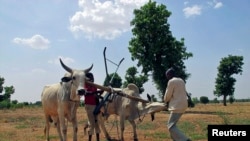A new study finds that Africa’s rural farmers can reduce carbon emissions and it won’t be such a big burden as was once thought.
The International Fund for Agricultural Development, IFAD, and the CGIAR Research Program on Climate Change, Agriculture and Food Security (CCAFS) say helping farmers adapt to the impacts of climate change can significantly reduce greenhouse gas emissions.
The report shows that smallholder farmers are a key part in solving climate change threats and food security challenges. With proper investments, the report says farmers can restore degraded ecosystems and reduce agriculture’s carbon footprint and still feed a growing planet.
Eva Wollenberg is one of the authors of the CGIAR report. She describes the mitigation potential of small-holder farmers. “We believe the potential would be about one giga-ton of CO-2 equivalent per year for all of agriculture. And if we estimate that about one-third of emissions come from small-holders now, we would then extrapolate to say that about point-three giga-tons would be possible.
“But that is a very rough estimate based both on population numbers that come from a variety of different sources - modeling that relies on many assumptions - and so these numbers need to be treated with caution.”
Increased efficency in Vietnam’s rice paddies
Wollenberg said what this means is that the techniques that the farmers are using are not only producing low emissions but are also enabling farmers to be more resilient to the effects of climate change through increased efficiency of their inputs.
“For instance, in the case of paddy rice - and now I’m thinking specifically of the Mekong Delta in Vietnam - water shortages in the Mekong due to sea levels dropping and salt water intrusion into the Delta area have meant that there’s less water for irrigation. And the Vietnamese government has been very interested in how to save water,” Wollenberg said.
“At the same time, we know that we can reduce emissions from paddy rice - mainly methane - by draining the field midway through the season, and even draining the field several times because that reduces the bacteria that actually produce the methane.
‘We can adjust those problems,” Wollenberg said. “We can save water and we can reduce the methane.” This is done through irrigation.
The balancing act in Africa
In Africa where rainfall is more erratic, finding the balance of reducing greenhouse gas emissions through irrigation while at the same time draining the fields at the appropriate times is more of a challenge said Wollenberg.
“For East Africa what we’re concentrating on is primarily reductions of emissions from livestock. About 80 percent of the emissions are from livestock. One of the opportunities that we see is the sustainable intensification of livestock - namely improving the feed doing what’s call zero grazing - so enabling the livestock to be fed in place rather than grazing freely. And also, especially enabling better feeding during the dry season so that production can be more even throughout the year,” explained Wollenberg.
She said better methods not only improve the overall productivity of the livestock, particularly cattle, but they will also reduce emissions because improved feeding reduces the dry digestible matter that, in turn, will reduce the methane gas that cattle emit.
Wollenberg added, “We’re also somewhat looking at manure management, but the real focus of our work is on the improved productivity of the cattle through this improved feed, and the zero grazing, and then reducing emissions..”









